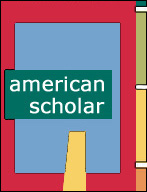Dramatica Theory of Story

Here is a unique theory about the elements inolved in writing a complete story. It comes from chapter two in the Dramatica Theory Book, developed by Melanie Anne Phillips and Chris Huntley. If this overview whets your appetite for more, visit Dramatica.com.
Foundations: Central Concepts
In Dramatica, there are some central concepts that prove immediately useful. Presenting these up front reveals the practical side of the theory and provides a firm
foundation for more in-depth explorations to come.
These central concepts are:
1. The Story Mind
2. The Four Throughlines
3. The Objective Story Throughline
4. The Main Character Throughline
5. The Obstacle Character Throughline
6. The Subjective Story Throughline
7. The Grand Argument Story
The Story Mind
One of the unique
concepts that sets Dramatica apart from all other theories is the assertion
that every complete story is a model of the mind's problem solving process.
This Story Mind does not work like a computer, performing one operation
after another until the solution is obtained. Rather, it works more holistically,
like our own minds, bringing many conflicting considerations to bear on
the issue. It is the author's argument as to the relative value of these
considerations in solving a particular problem that gives a story its
meaning.
To make his case, an author must examine all significant approaches to
resolving the story's specific problem. If a part of the argument is left
out, the story will have holes. If the argument is not made in an even-handed
fashion, the story will have inconsistencies.
Characters, Plot, Theme, and Genre are the different families of
considerations in the Story Mind made tangible, so audience members can
see them at work and gain insight into their own methods of solving problems.
Characters represent the motivations of the Story Mind (which often work
at cross purposes and come into conflict). Plot documents the problem
solving methods employed by the Story Mind. Theme examines the relative
worth of the Story Mind's value standards. Genre establishes the Story
Mind's overall attitude, which casts a bias or background on all other
considerations. When a story is fully developed, the model of the Story
Mind is complete.
To see the third perspective,
keep yourself in the shoes of the Main Character for a moment. You are
right in the middle of the story's battle. Smoke from dramatic explosions
obscures the field. You are not absolutely sure which way leads to safety.
Still, before there was so much turmoil, the way was clear and you are
confident in your sense of direction.
Then, from out of the smoke a shadowy figure appears, solidly blocking
your way. The shadowy figure is your Obstacle Character.
You can't see well enough to tell if he is friend or foe. He might be
a compatriot trying to keep you from stepping into a mine field. Or, he
might be the enemy luring you into a trap. What to do! Do you keep on
your path and run over this person or try the other path instead? This
is the dilemma that faces a Main Character.
To completely explore the issue at the heart of a story, an Obstacle Character
must present an alternative approach to the Main Character. The Obstacle
Character Throughline describes the advocate of this alternative
path and the manner in which he impacts Main Character.
As soon as the Main
Character encounters his Obstacle, a skirmish ensues at a personal level
in the midst of the battle as a whole. The two characters close in on
one another in a theatrical game of "chicken," each hoping the
other will give in.
The Main Character shouts at his Obstacle to get out of the way. The Obstacle
Character stands fast, insisting that the Main Character change course
and even pointing toward the fork in the road. As they approach one another,
the interchange becomes more heated until the two are engaged in heart-to-heart
combat.
While the Objective Story battle rages all around, the Main and Obstacle
Characters fight their private engagement. The Subjective Story
Throughline describes the course this passionate battle takes.
Here are some examples of how to see the four throughlines of some well known stories. Completed stories tend to blend these throughlines together in the interest of smooth narrative style. From a structural point of view, however, it is important to see how they can be separated.
Star Wars
Objective Story
Throughline: The Objective view of Star Wars sees a
civil war in the galaxy between the Rebels and the evil Empire. The Empire
has built a Death Star which will destroy the Rebels if it isn't destroyed
first. To even hope for a successful attack, the Rebels need the plans
to the Death Star which are in the possession of a farm boy and an old
Jedi master. These two encounter many other characters while delivering
the plans, ultimately leading to a climactic space-battle on the surface
of the Death Star.
Main Character Throughline: The Main Character of Star Wars
is Luke Skywalker. This throughline follows his personal growth over the
course of this story. Luke is a farm boy who dreams of being a star pilot,
but he can't allow himself to leave his foster parents to pursue his dreams.
He learns that he is the son of a great Jedi Knight. When his foster parents
are killed, he begins studying the religion of the Jedi: the Force. Surviving
many dangerous situations, Luke learns to trust himself more and more.
Ultimately he makes a leap of faith to trust his feelings over his computer
technology while flying into battle as the Rebel's last hope of destroying
the Death Star. It turns out well, and Luke is changed by the experience.
Obstacle Character Throughline: The Obstacle Character of Star
Wars is Obi Wan Kenobi and this throughline describes his impact
(especially on Luke Skywalker) over the course of the story. Obi Wan is
a wizened old Jedi who sees everything as being under the mystic control
of the Force. He amazes people with his resiliency and ability, all of
which he credits to the Force.
Subjective Story Throughline: The Subjective Story throughline of
Star Wars describes the relationship between Luke and Obi
Wan. Obi Wan needs Luke to help him and he knows Luke has incredible potential
as a Jedi. Luke, however, needs to be guided carefully because his desires
are so strong and his abilities so new. Obi Wan sets about the manipulations
which will help Luke see the true nature of the Force and learn to trust
himself.
To Kill A Mockingbird
Objective Story
Throughline: The Objective view of To Kill A Mockingbird
sees the town of Maycomb with its horns locked in various attitudes over
the rape trial of Tom Robinson. Due-process has taken over, however many
people think this case should never see trial. As the trial comes to fruition,
the people of the town argue back and forth about how the defense lawyer
ought to behave and what role people should take in response to this alleged
atrocity.
Main Character Throughline: The Main Character of To Kill
A Mockingbird is Scout and her throughline describes her personal
experiences in this story. Scout is a young tom-boy who wants things in
her life to remain as simple as they've always been. Going to school,
however, and seeing the town's reaction to her father's work introduces
her to a new world of emotional complexity. She learns that there is much
more to people than what you can see.
Obstacle Character Throughline: The Obstacle Character point of
view in To Kill A Mockingbird is presented through Boo Radley,
the reclusive and much talked about boy living next door to Scout. The
mystique surrounding this boy, fueled by the town's ignorance and fear,
make everyone wonder what he is really like and if he's really as crazy
as they say.
Subjective Story Throughline: The Subjective Story view of To
Kill A Mockingbird sees the relationship between Scout and Boo
Radley. This throughline explores what it's like for these two characters
to live next door to each other and never get to know one another. It
seems any friendship they might have is doomed from the start because
Boo will always be locked away in his father's house. The real problem,
however, turns out to be one of Scout's prejudice against Boo's mysterious
life. Boo has been constantly active in Scout's life, protecting her from
the background. When Scout finally realizes this she becomes a changed
person who no longer judges people without first trying to stand in their
shoes.
We have described
a story as a battle. The overview that takes in the full scope of the
battle is the Objective Story Throughline.
Within the fray is one special soldier through whom we experience the
battle first-hand. How he fares is the Main Character Throughline.
The Main Character is confronted by another soldier, blocking the path.
Is he friend or foe? Either way, he is an obstacle, and the exploration
of his impact on the Main Character is the Obstacle Character Throughline.
The Main and Obstacle Characters engage in a skirmish. Main says, "Get
out of my way!", and Obstacle says, "Change course!" In
the end, the steadfast resolution of one will force the other to change.
The growth of this interchange constitutes the Subjective Story Throughline.
Taken together, the four throughlines comprise the author's argument to
the audience. They answer the questions: What does it feel like to have
this kind of problem? What's the other side of the issue? Which perspective
is the most appropriate for dealing with that problem? What do things
look like in the "big picture?"
Only through the development of these four simultaneous throughlines can
the Story Mind truly reflect our own minds, pitting reason against emotion
and immediate advantage against experience in the hope of resolving a
problem in the most beneficial manner.
Moving On
Now that you've added Story Mind, Objective Story Throughline, Main Character Throughline, Obstacle Character Throughline, and Subjective Story Throughline to your writer's vocabulary, you have all the background you need to explore a whole new world of understanding: the Dramatica Theory of Story.

